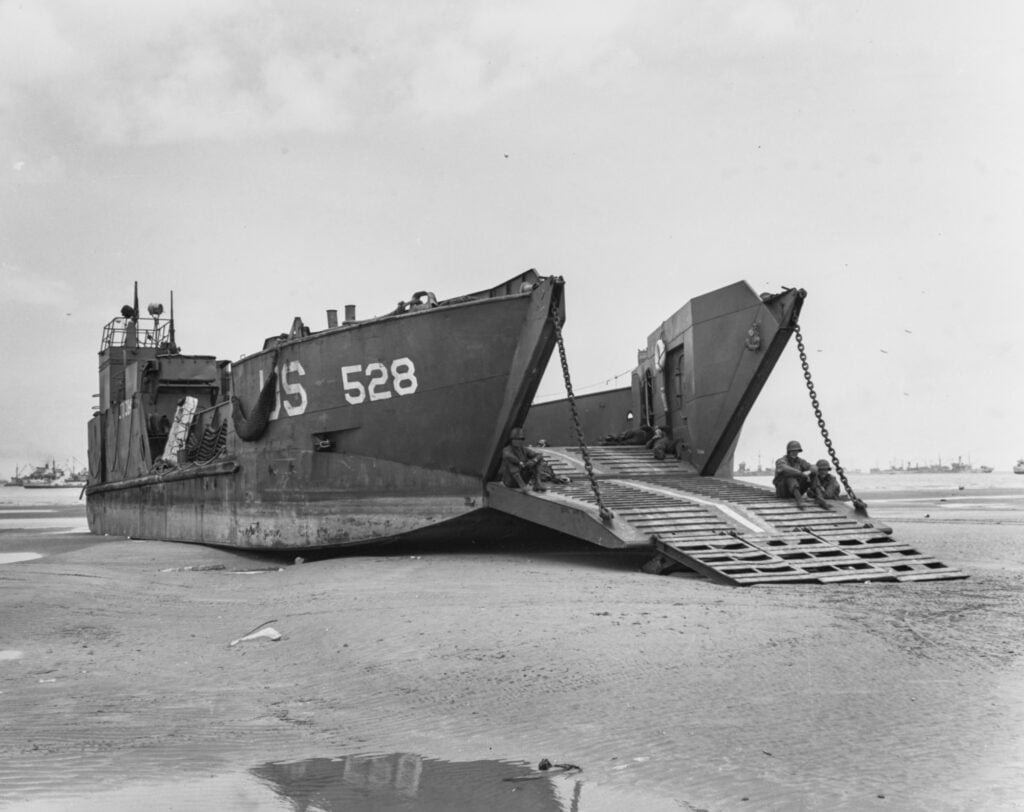Designed to land tanks and many other types of vehicles, beginning in the early hours of an amphibious landing. The type originated as a British concept, and the LCT(1) was first trialled in November 1940. The main types of Landing Craft, Tank used in the Normandy campaign were the LCT(3) and LCT(4), designed and built by the British, and the US-designed/built LCT(5) and LCT(6). The LCT(5) and LCT(6) were designed to be transported across the Atlantic on the deck of an LST.

Above: British LCT(4)s dried out for unloading on a Normandy beach after D-Day. At this time such craft continued to make regular Channel crossings carrying further troops to France. (Photo: US Coast Guard)
The Landing Craft, Tank was second only to the LST in the number of vehicles it could carry. Around 870 LCTs of all Marks were used in the operation, or some 960 if you include the various fire support variants that were based on an LCT hull. While a number were lost or so badly damaged that they were written off, it is also surprising how much damage some absorbed while at least still getting their crews safely off the beach again.
The pennant number (US term: hull number) of LCTs used by the British indicates the type: those numbered 300 to 499 and 7001 to 7150 were LCT(3)s, those numbered 500 to 1364 were LCT(4)s. An LCT(5) or LCT(6) in British service had 2,000 or 3,000 respectively added to the pennant number allocated by the US: LCT 2 became LCT 2002 for example. Under the original US numbering, LCT(5) had pennant (hull) numbers up to 500, and LCT(6) were numbered 501 and upwards.

Above: LCT(6) 528 of the US Navy, dried out on a Normandy beach (probably Utah, on 14 June 1944). (Photo: US Navy photo by Combat Photo Unit 11, at US National Archives)
Confusingly, both British- and US-built LCTs took part in Operation Neptune that had the same pennant number: for example LCT(4) 650 was crewed by the Royal Navy and part of Force S, while the US Navy’s LCT(6) 650 was in Force O. Some types of Landing Craft, Tank performing special roles on D-Day were designated LCT(A), LCT(HE) or LCT(CB). Often these types were collectively referred to as LCT(A). These craft had a temporary platform fitted on the tank deck so that one or two of the army’s tanks could fire from that position as the craft approached the beach. This was a way of supplementing the naval fire support before H-Hour.
Sources for more information:
Adcock, Al, WWII US Landing Craft in Action. Warships No.17. (Carrollton, TX: Squadron/Signal, 2003).
Doyle, David, US Landing Craft of WWII, Vol.2. The LCT, LSM, LCS(L)(3) and LST. (Atglen, PA: Schiffer, 2020).